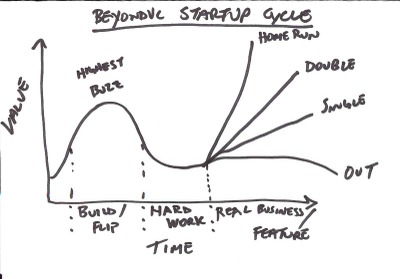I never made it to the Web 2.0 conference yesterday, and you know how I feel about that label :-). Anyway, I happened to be in San Francisco for a portfolio company board meeting and some other events. After a Nokia boat cruise with many of the team that launched the awesome Nokia Internet 810 tablet (I will get myself one of those), I had the opportunity to go to a MySpace party to celebrate the opening of their San Francisco office. I had a great time and while I ran into many friends from the Bay Area, what I enjoyed most was bumping into many of the original New York entrepreneurs that I have known over the last 10 years. In a scary way, it felt like it was 1997 all over again, and we were at a networking event in New York talking about their first startups. The only difference is that it is 10 years later, and we have greyer hair. Jeff Stewart who was part of the Proxicom rollup and founded Mimeo and now Monitor110, said that everywhere he turned he ran into another New York entrepreneur. Standing next to me was Andrew Erlichson founder of Flashbase (sold to Doubleclick) who I funded years ago and now CEO of Phanfare, across the room was Andrew Weinreich of sixdegrees and now meetmoi, and on the other side of the room was Jason Calacanis of the Silicon Alley Reporter and Weblogs and now Mahalo. While he is in LA now, I still count him as an original New York entrepreneur. Jeff and i tried to organize a group picture but just could not make it happen.
You may be thinking to yourself who cares or why is Ed namedropping? There is a simple answer – I have known many of these guys for the last dozen or so years since the first Internet wave, and it is simply awesome to see everyone still plugging away, following their passions, getting smarter and better, and continuing to build the New York entrepreneurial ecosystem. I know we are no Silicon Valley, but it is great to see these entrepreneurs all working on their second and third companies. It was also great to hear their stories of raising their first or second or third rounds of capital for their most recent companies. When I started as a VC in 1996 and first met many of these entrepreneurs, it was clear that we were all starting from scratch. We didn’t know what we didn’t know. We didn’t have entrepreneurs working on their second and third startups back then. What we had was energy and passion. And yes I agree that the whole Silicon Alley movement was pure hype and ridiculous but for those of us who have stuck around we have learned a lot and we are on the cusp of doing some great things. We now have energy, passion, and grey hair which is a great combination. I said it before in my NYC 2.0 pitch a couple years ago, but I believe that everyday our world here is getting more and more important as the media companies and advertisers try to make sense of this new era of communications. As companies like Google and AOL and others continue to build a bigger and stronger presence here, it will continue to make us better. True to form, I have already seen my first couple of spinouts from the Google New York office, and I expect to see many more. But it is many of these guys that I hung out with above who were some of the original pioneers in New York that have helped blaze a path for many of the new entrepreneurs we are seeing today. When the bubble popped, they didn’t quit and go home. They continued to fight and continued to build new companies and for that we should all be thankful because today the New York ecosystem is building and getting stronger. The funny part is that it took me being 3000 miles from home to have this revelation again.
